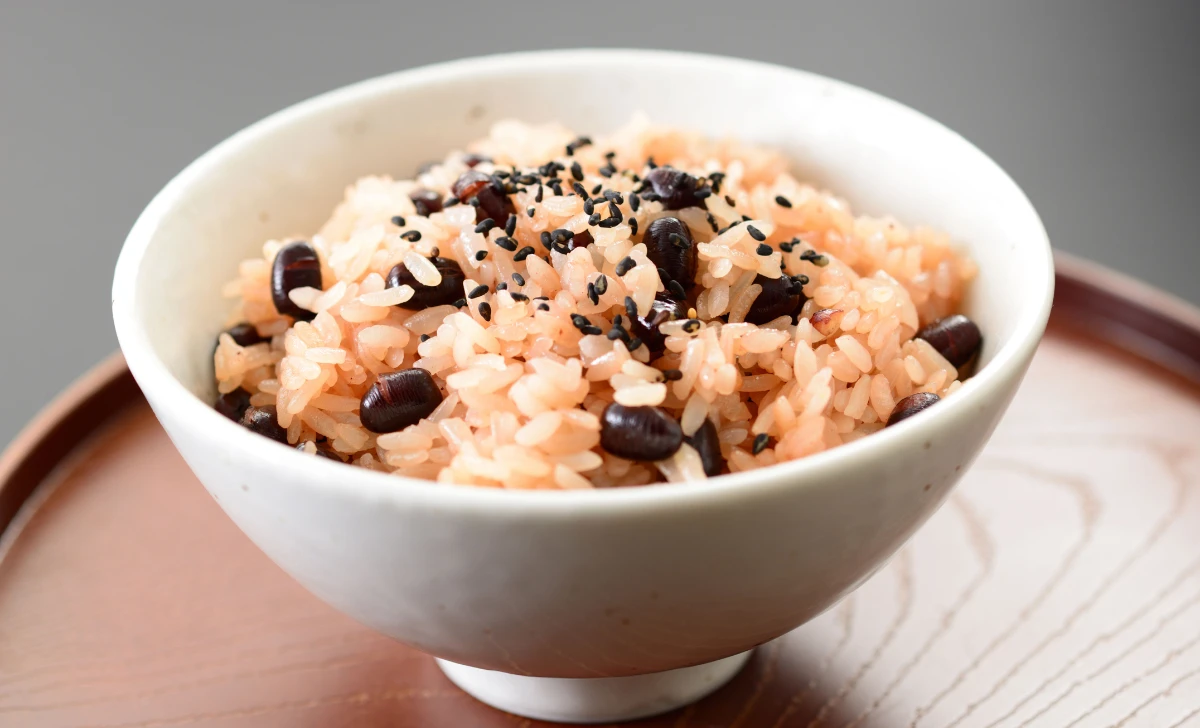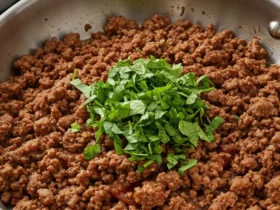Cooking a delicious and wholesome meal doesn’t have to be complicated. If you’re looking for a comforting and nutritious dish, look no further than this Steamed Rice with Adzuki Beans recipe. This simple yet hearty recipe brings together the nutty flavor of adzuki beans and the fluffy goodness of steamed rice. Whether you’re a seasoned cook or just getting started in the kitchen, this dish is sure to become a staple in your culinary repertoire.
[ez-toc]
History
The history of the delectable dish, Steamed Rice with Adzuki Beans, is a fascinating tapestry woven with culinary traditions, nutritional wisdom, and a touch of creativity. This beloved recipe has stood the test of time, evolving from humble origins into a staple on tables around the world.
Early Roots and Cultural Influences
The roots of the Steamed Rice with Adzuki Beans recipe can be traced back to the heart of Asia. Adzuki beans, with their vibrant red hue and nutty flavor, have been a cherished ingredient in Asian cuisine for centuries. These beans found their way into a variety of dishes, adding both taste and nutrition to traditional diets.
The simplicity of combining adzuki beans with rice was born out of a necessity for wholesome sustenance. In cultures where rice was a dietary staple, adding protein-rich adzuki beans not only enhanced the nutritional value of the meal but also created a satisfying and balanced plate.
Nutritional Wisdom and Wellness
As time went on, the nutritional benefits of adzuki beans became more recognized. Ancient healing systems, such as Ayurveda and Traditional Chinese Medicine, lauded the beans for their ability to support digestion, boost energy, and promote overall vitality. These insights further solidified adzuki beans as an essential ingredient in health-conscious diets.
The art of steaming rice and beans together brought out the best of both worlds. The light, fluffy rice provided a neutral canvas for the flavors of the beans to shine, creating a harmony that not only pleased the palate but also contributed to a well-rounded diet.
Global Spread and Culinary Adaptations
As trade routes expanded and cultures intermingled, so did the reach of the Steamed Rice with Adzuki Beans recipe. The simplicity and versatility of the dish allowed it to cross geographical boundaries and adapt to different culinary traditions. Whether served as a main dish, a side, or even a dessert, the combination of rice and adzuki beans resonated with people from various walks of life.
In Japan, the dish evolved into “Zensai,” a sweet red bean paste used in traditional confections. In Korea, “Patjuk” emerged, a hearty porridge made from adzuki beans and rice, enjoyed during festive occasions. These adaptations showcase the resilience of the basic concept while embracing regional flavors and preferences.
Modern Revival and Culinary Innovation
In the modern era, where convenience often takes precedence, the Steamed Rice with Adzuki Beans recipe has experienced a revival. As people seek healthier, plant-based options, this dish stands as a shining example of simplicity, taste, and nourishment. It has found its place in the menus of health-conscious eateries and home kitchens alike.
Moreover, culinary enthusiasts have taken this traditional recipe and added their own flair. Spices, herbs, and additional ingredients have been introduced, turning a simple dish into a canvas for culinary experimentation. The rise of fusion cuisine has also given birth to creative interpretations that marry the flavors of adzuki beans and rice with ingredients from around the world.
A Culinary Legacy Continues
In conclusion, the history of Steamed Rice with Adzuki Beans is a testament to the art of combining simple ingredients to create a dish that not only delights the senses but also nourishes the body. From its humble beginnings in Asian kitchens to its global presence today, this recipe has evolved while staying true to its essence. As we embrace culinary innovation and cultural exchange, the legacy of this dish continues to evolve, inspiring new generations of cooks and food enthusiasts to savor the harmonious blend of adzuki beans and steamed rice.
Time
| Step | Time Required |
|---|---|
| Preparing Adzuki Beans | 8 – 12 hours |
| Cooking the Rice | 25 – 30 minutes |
| Bringing It All Together | 5 – 10 minutes |
| Total | 38 – 52 minutes |
Please note that the time mentioned is approximate and may vary based on factors such as cooking equipment, altitude, and personal cooking speed.
Ingredients
| Ingredients | Quantity |
|---|---|
| Adzuki beans (dried or canned) | 1/2 cup |
| Long-grain white rice | 1 cup |
| Water or vegetable broth | 2 cups |
| Pinch of salt | To taste |
| Spices and herbs of your choice | As desired |
These quantities are tailored for a serving size of two people and can be adjusted based on your preferences and appetite.
Directions
1. Preparing Adzuki Beans
- If using dried adzuki beans, rinse them thoroughly under cold water to remove any dirt or debris.
- Place the rinsed beans in a bowl and cover them with water. Allow them to soak for 8 to 12 hours or overnight. This softens the beans and reduces their cooking time.
- After soaking, drain and rinse the beans again.
- In a pot, add the soaked adzuki beans and cover them with water. Bring the water to a boil, then reduce the heat to a simmer.
- Let the beans cook for about 30-40 minutes, or until they are tender but not mushy. You should be able to easily smash a bean between your fingers.
- Drain the cooked beans and set them aside.
2. Cooking the Rice
- Start by washing the long-grain white rice under cold water until the water runs clear. This helps remove excess starch and prevents the rice from becoming too sticky.
- In a pot, combine the washed rice with 2 cups of water or vegetable broth. This liquid will ensure the rice cooks properly and absorbs flavor.
- Add a pinch of salt to the pot to enhance the taste of the rice.
- Bring the liquid to a boil over medium-high heat.
- Once boiling, reduce the heat to low, cover the pot with a lid, and let the rice simmer for 15-20 minutes. The rice should absorb the liquid and become fluffy.
3. Bringing It All Together
- In a separate pan, combine the cooked adzuki beans and the cooked rice.
- Gently fold the beans and rice together to ensure an even distribution of flavors.
- If desired, add spices and herbs of your choice at this stage. This is where you can get creative and tailor the flavors to your liking.
- Let the mixture steam together for 5-10 minutes. This allows the ingredients to meld and their flavors to harmonize.
Tips for Flavorful Perfection
1. Spice It Up
- Enhance the flavors of your dish by adding a touch of your favorite spices. Consider options like cumin, paprika, or turmeric to elevate the taste profile.
2. Textural Delights
- If you enjoy a variety of textures, experiment by mixing in cooked quinoa or chopped nuts. This adds a delightful crunch and boosts the nutritional content of the dish.
Serving and Presentation
- To serve, plate the Steamed Rice with Adzuki Beans with care. Use a spoon to scoop the mixture onto individual plates.
- For an added burst of color and freshness, consider garnishing the dish with a sprinkle of fresh herbs, such as chopped cilantro or parsley.
Why This Recipe Rocks
- This recipe is a testament to the beauty of simplicity. By combining just a few humble ingredients, you create a dish that’s both wholesome and flavorful.
- The pairing of adzuki beans and rice showcases the power of balance, where the nutty beans complement the mildness of the rice perfectly.
Making It Your Own
- Don’t be afraid to get creative with this recipe. Add sautéed vegetables, drizzle with a homemade sauce, or experiment with different herbs to make it uniquely yours.
Enjoy the rich flavors and nourishing goodness of your homemade Steamed Rice with Adzuki Beans. This dish is not only a treat for your taste buds but also a celebration of the art of cooking.
Equipment Required
Nutrition Information
| Nutrition Information | Per Serving (2 people) |
|---|---|
| Serving Size | 1 plate |
| Calories | 350-400 calories |
| Total Fat | 1-2g |
| Saturated Fat | 0g |
| Trans Fat | 0g |
| Cholesterol | 0mg |
| Sodium | 200-250mg |
| Total Carbohydrates | 70-80g |
| Dietary Fiber | 8-10g |
| Sugars | 1-2g |
| Protein | 8-10g |
| Vitamin D | 0% |
| Calcium | 2% |
| Iron | 10-15% |
| Potassium | 8% |
Please note that the provided nutrition information is an estimate and can vary based on the specific ingredients and portion sizes used.
Tips
- Soaking Beans: If using dried adzuki beans, plan ahead and soak them overnight. This reduces cooking time and ensures even cooking.
- Rinsing Rice: Thoroughly rinse the rice until the water runs clear. This prevents excess starchiness and leads to fluffier rice.
- Liquid Ratios: Use a 1:2 ratio of rice to liquid for perfectly cooked rice. Adjust the amount of water or broth based on your rice variety.
- Herbs and Spices: Experiment with spices like cumin, coriander, or smoked paprika for added depth. Fresh herbs like thyme or rosemary can also elevate the flavor.
- Texture Play: Incorporate different textures by adding chopped nuts (like almonds or cashews) or cooked quinoa to the dish.
- Garnishing: Freshly chopped herbs or a drizzle of olive oil before serving can enhance both the visual appeal and taste.
- Rice Fluffing: Once the rice is cooked, let it sit covered for a few minutes before fluffing it with a fork. This helps separate the grains.
Pros & Cons
| Pros | Cons |
|---|---|
| ✅ Nutritious and balanced meal | ❌ Requires pre-soaking beans |
| ✅ Plant-based protein source | ❌ Longer cooking time for beans |
| ✅ Customizable with spices | ❌ May require some culinary confidence |
| ✅ Simple ingredients and flavors | ❌ Not suitable for low-carb diets |
| ✅ Can be adapted for various diets | ❌ May not appeal to picky eaters |
Conclusion
In a world filled with culinary complexity, the Steamed Rice with Adzuki Beans recipe stands as a beacon of simplicity and wholesome goodness. This harmonious blend of nutty adzuki beans and fluffy rice not only tickles your taste buds but also nourishes your body with plant-based protein and essential nutrients.
With every bite, you’re savoring the rich history of Asian cuisine and the wisdom of nutritional well-being. The recipe’s versatility allows for personal touches, whether it’s experimenting with spices, adding crunchy textures, or embracing a fusion of flavors.
Imagine the satisfaction of a plate that’s both comforting and nutritious, prepared with your creativity as the secret ingredient. From its humble beginnings to its modern adaptations, this recipe has stood the test of time, promising a culinary experience that’s both timeless and satisfying.
So why not embark on this culinary journey? Gather the ingredients, infuse your kitchen with aromatic aromas, and enjoy the satisfaction of creating a dish that’s not just food but an expression of care for yourself and your loved ones. The Steamed Rice with Adzuki Beans recipe invites you to explore the art of simplicity while embracing the joy of nourishing both your palate and your well-being. Go ahead, give it a try, and savor the delightful flavors and comforts it brings to your table.
Facts
- Fact 1: 🌱 The Magic Bean Dance
- Did you know that adzuki beans are considered a symbol of good luck in some cultures? In Japan, there’s a tradition of throwing adzuki beans during the Setsubun festival to drive away evil spirits. It’s like a magical bean dance that adds a touch of fun to this humble ingredient!
- Fact 2: 🌏 From Far East to Fusion
- While adzuki beans have deep roots in Asian cuisine, their popularity has transcended borders. From Japan’s sweet red bean paste to Korea’s hearty patjuk, adzuki beans have inspired dishes around the world. It’s like a flavorful passport that’s traveled far and wide!
- Fact 3: 🍚 Rice – The Global Canvas
- Rice is more than just a side dish; it’s a canvas for culinary artistry. In India, rice is transformed into biryanis bursting with flavor, while in Japan, it’s the canvas for delicate sushi. Steamed Rice with Adzuki Beans showcases rice’s versatility, allowing flavors to play and paint across its grains.
- Fact 4: 🕰️ The Ancient Love for Adzuki
- The love for adzuki beans is ancient! They’ve been enjoyed for over 6,000 years. These little beans have witnessed the rise and fall of empires, the evolution of culinary techniques, and they’ve remained a staple on tables through the ages. It’s like a timeless treasure, passed down through generations.
- Fact 5: 🧙♀️ Kitchen Alchemy: Turning Beans Sweet
- Adzuki beans have a secret life as dessert wizards! In Asia, they’re transformed into sweet pastes, stuffed into pastries, and even swirled into ice creams. It’s like beans performing culinary magic tricks, turning from savory to sweet with a wave of a spatula.
FAQ’s
Can I use canned adzuki beans?
Yes, absolutely! Canned adzuki beans are a convenient alternative. Just make sure to drain and rinse them before using.
Can I freeze leftovers?
Definitely! Store any leftovers in an airtight container and freeze them. When you’re ready for another delicious meal, thaw and reheat gently.
Can I use a rice cooker for this recipe?
Of course! A rice cooker works perfectly. After cooking the rice and beans separately, simply combine them in the rice cooker and let them steam together for a few minutes.
Can I substitute brown rice?
Absolutely. Brown rice is a fantastic option, adding a nuttier flavor and extra nutrients. Adjust the cooking time as needed since brown rice generally takes longer to cook.
How can I add more vegetables to this dish?
Get creative! Sautéed greens like spinach or kale, roasted vegetables, or stir-fried bell peppers are wonderful options to introduce more color and nutrition.
Is this recipe gluten-free?
Yes, this recipe is naturally gluten-free. Just ensure that any spices or additional ingredients you use are also gluten-free.
Can I use other types of beans?
Definitely! While adzuki beans are traditional, you can use black beans, pinto beans, or chickpeas for a unique twist.
Can I add a protein source to this dish?
Absolutely. You can add tofu, tempeh, or grilled chicken to make it a heartier meal. Just cook the protein separately and mix it in before steaming.
Can I make this recipe spicy?
Of course! Add chili flakes, cayenne pepper, or your favorite hot sauce to give the dish a spicy kick. Adjust the amount to your heat preference.
Can I use frozen adzuki beans instead of dried or canned?
Yes, you can use frozen adzuki beans. Follow the package instructions for cooking, and once they’re tender, proceed with the recipe as normal.












Leave a Review